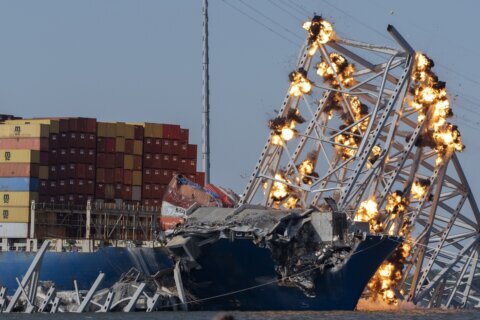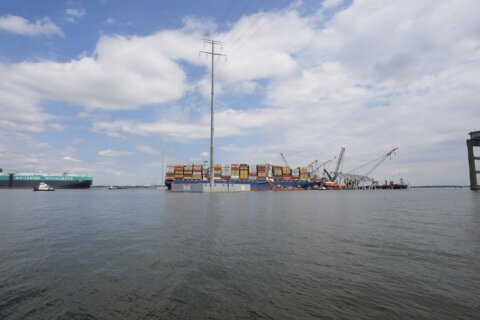Follow WTOP’s latest coverage of the Baltimore Key Bridge collapse and ongoing recovery efforts.
Small explosive charges will be used to cut apart and remove a large section of the wreckage of Baltimore’s Francis Scott Key Bridge that’s draped across the front of the container ship Dali.
A U.S. Army Corps of Engineers video animation released by the Unified Command depicts how crews will use the “precision cutting” technique to cut apart the large steel truss that has remained across the bow of the Dali since the cargo ship crashed into the Baltimore bridge on March 26, causing much of the bridge to collapse into the Patapsco River.
After analyzing the bridge to determine where cuts should be made, crews will make holes where the explosives will be placed, and secured with a wrapping “similar to a large piece of tape,” according to the video.
When the small charges are detonated, the video narration says “the steel structure will be thrust away from the Dali,” and shows separated pieces of steel falling into the river.
“It’s important to note that this controlled demolition is not like what you would see in a movie,” according to the narration. “From a distance, it will sound like fireworks or loud thunder, and appear as puffs of smoke” during the procedure, which is expected to take two to five seconds, according to the Unified Command.
Key Bridge cleanup officials are recommending ear protection for anyone within the project’s 2,000-yard safety zone, which includes a small portion of Hawkins Point.
The exact time of the detonation will be determined based on environmental and operational factors, according to officials.
“These steps will be conducted methodically, safely, and with rigorous attention to detail as we work toward opening the federal channel,” according to the video.
The Army Corps of Engineers has estimated the main shipping channel, which is 700 feet wide and 50 feet deep, will be reopened by the end of May.
Four temporary channels have been opened since the bridge’s collapse, allowing container ships to access the Port of Baltimore.
Get breaking news and daily headlines delivered to your email inbox by signing up here.
© 2024 WTOP. All Rights Reserved. This website is not intended for users located within the European Economic Area.








